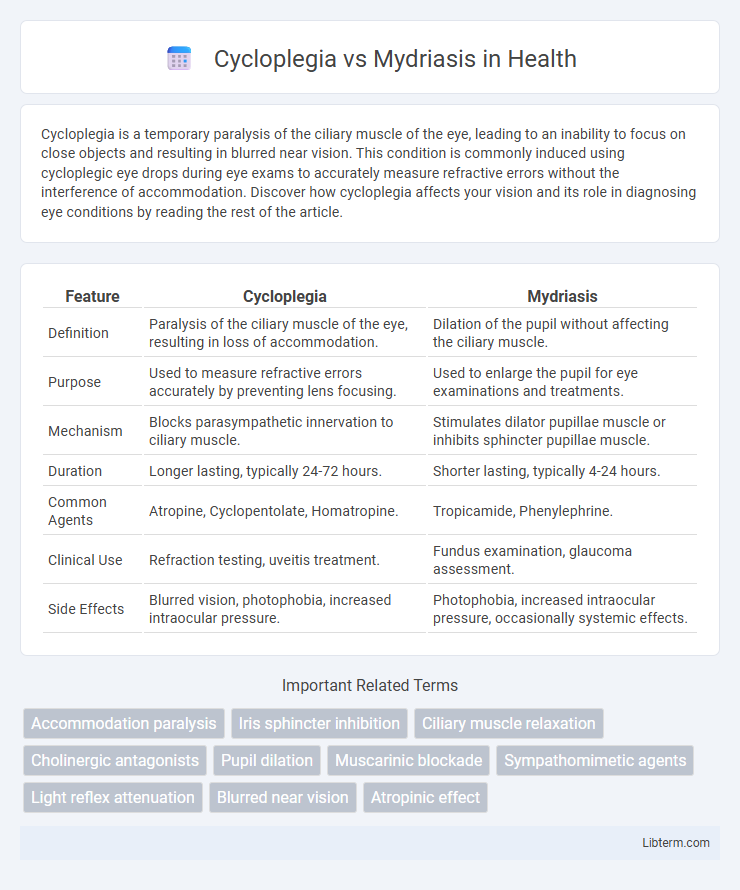Cycloplegia is a temporary paralysis of the ciliary muscle of the eye, leading to an inability to focus on close objects and resulting in blurred near vision. This condition is commonly induced using cycloplegic eye drops during eye exams to accurately measure refractive errors without the interference of accommodation. Discover how cycloplegia affects your vision and its role in diagnosing eye conditions by reading the rest of the article.
Table of Comparison
| Feature | Cycloplegia | Mydriasis |
|---|---|---|
| Definition | Paralysis of the ciliary muscle of the eye, resulting in loss of accommodation. | Dilation of the pupil without affecting the ciliary muscle. |
| Purpose | Used to measure refractive errors accurately by preventing lens focusing. | Used to enlarge the pupil for eye examinations and treatments. |
| Mechanism | Blocks parasympathetic innervation to ciliary muscle. | Stimulates dilator pupillae muscle or inhibits sphincter pupillae muscle. |
| Duration | Longer lasting, typically 24-72 hours. | Shorter lasting, typically 4-24 hours. |
| Common Agents | Atropine, Cyclopentolate, Homatropine. | Tropicamide, Phenylephrine. |
| Clinical Use | Refraction testing, uveitis treatment. | Fundus examination, glaucoma assessment. |
| Side Effects | Blurred vision, photophobia, increased intraocular pressure. | Photophobia, increased intraocular pressure, occasionally systemic effects. |
Introduction to Cycloplegia and Mydriasis
Cycloplegia refers to the temporary paralysis of the ciliary muscle of the eye, resulting in a loss of accommodation and inability to focus on near objects, commonly induced by cycloplegic agents like atropine. Mydriasis is the dilation of the pupil caused by the relaxation of the iris sphincter muscle, often used during eye examinations to allow a better view of the retina. Both conditions are clinically significant for diagnosing refractive errors and retinal conditions, with cycloplegia primarily affecting accommodation and mydriasis affecting pupil size.
Definition of Cycloplegia
Cycloplegia is the paralysis of the ciliary muscle of the eye, resulting in a loss of accommodation and inability to focus on near objects. This condition is induced by cycloplegic agents, which temporarily halt the muscle's function to aid in accurate refraction assessment during eye examinations. Unlike mydriasis, which only causes pupil dilation, cycloplegia affects both pupil size and the eye's focusing ability.
Definition of Mydriasis
Mydriasis is the dilation of the pupil, often caused by exposure to low light, certain medications, or neurological factors, allowing more light to enter the eye. Unlike cycloplegia, which involves paralysis of the ciliary muscle affecting lens accommodation, mydriasis specifically pertains to the enlargement of the pupil without directly impacting focusing ability. This condition can be physiological or pharmacological and is crucial for diagnostic and therapeutic processes in ophthalmology.
Mechanisms of Cycloplegia
Cycloplegia results from the paralysis of the ciliary muscle, preventing the eye from changing the lens shape for accommodation, primarily due to anticholinergic agents blocking muscarinic receptors. In contrast, mydriasis is the dilation of the pupil caused by the relaxation of the iris sphincter muscle or stimulation of the dilator pupillae muscle. Cycloplegia specifically disrupts accommodation while mydriasis mainly affects pupil size without necessarily impacting the lens.
Mechanisms of Mydriasis
Mydriasis occurs through the activation of the sympathetic nervous system, specifically by stimulating the dilator pupillae muscles in the iris, which leads to pupil dilation. This mechanism involves the release of norepinephrine binding to alpha-1 adrenergic receptors on the iris dilator muscle, causing contraction and enlargement of the pupil. In contrast, cycloplegia results from the paralysis of the ciliary muscle, primarily due to muscarinic receptor antagonists, impairing accommodation without directly affecting pupil size.
Key Differences Between Cycloplegia and Mydriasis
Cycloplegia paralyzes the ciliary muscle, leading to loss of accommodation, whereas mydriasis causes dilation of the pupil without affecting accommodation. Cycloplegia primarily results from agents like atropine that block accommodation reflex, while mydriasis is induced by drugs such as phenylephrine that stimulate the dilator pupillae muscle. The clinical significance is that cycloplegia impairs focusing on near objects, while mydriasis mainly affects light entry and pupil size.
Clinical Uses of Cycloplegic Agents
Cycloplegic agents are primarily used in clinical settings to facilitate accurate refraction by temporarily paralyzing the ciliary muscle, preventing accommodation and revealing true refractive errors. These agents also aid in the diagnosis and treatment of uveitis by dilating the pupil and reducing pain caused by ciliary spasms. In contrast to mydriasis, which solely dilates the pupil, cycloplegia provides both pupil dilation and accommodation paralysis, making it essential for comprehensive eye examinations and certain therapeutic interventions.
Clinical Applications of Mydriatic Agents
Mydriatic agents are primarily used in clinical settings to facilitate comprehensive eye examinations by dilating the pupil, allowing ophthalmologists to inspect the retina and optic nerve for conditions such as diabetic retinopathy and glaucoma. Unlike cycloplegic agents, which paralyze the ciliary muscle to assess refractive errors and treat accommodation-related disorders, mydriatics mainly target the iris dilator muscle to achieve pupil dilation without affecting accommodation significantly. Common mydriatic drugs include tropicamide, phenylephrine, and atropine, each varying in onset and duration, tailored for diagnostic procedures or therapeutic interventions.
Side Effects and Safety Considerations
Cycloplegia, caused by drugs like cyclopentolate, temporarily paralyzes the ciliary muscle to prevent accommodation, often leading to side effects such as blurred vision, photophobia, and increased intraocular pressure, necessitating caution in patients with glaucoma. Mydriasis, achieved through agents like tropicamide, dilates the pupil but carries risks including glare sensitivity, potential angle-closure glaucoma, and systemic effects like tachycardia, especially in children or the elderly. Both conditions require careful monitoring for adverse reactions and contraindications, emphasizing safety in clinical use.
Conclusion: Cycloplegia vs Mydriasis in Eye Care
Cycloplegia and mydriasis serve distinct roles in eye care, with cycloplegia temporarily paralyzing the ciliary muscle to facilitate accurate refractive measurements, while mydriasis dilates the pupil primarily for retinal examination. Cycloplegic agents like atropine provide sustained cycloplegia, useful in diagnosing refractive errors and managing accommodative esotropia, whereas mydriatic drugs such as tropicamide allow quick pupillary dilation for fundus evaluation. Understanding the specific applications and pharmacodynamics of each ensures precise diagnosis and effective treatment in ophthalmology.
Cycloplegia Infographic

 libterm.com
libterm.com